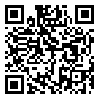BibTeX | RIS | EndNote | Medlars | ProCite | Reference Manager | RefWorks
Send citation to:
URL: http://ijn.iums.ac.ir/article-1-1577-en.html
2- Faculty member, Master in Medical-Surgical Nursing, Faculty of Nursing and Midwifery, Gonabad University of Medical Sciences, Gonabad, Iran
3- PhD candidate in Nursing, Faculty of Nursing and Midwifery, Iran University of Medical Sciences, Tehran, Iran
4- MS Student in Nursing, Faculty of Nursing and Midwifery, Tehran University of Medical Sciences, Tehran, Iran )Corresponding aauthor .( Tel:09153380020 Email: shareinia.msn@gmail.com ,
5- BS in Nursing, 15th Khordad Hospital, Gonabad University of Medical Sciences, Gonabad, Iran
Abstract
Background & Aim: The high prevalence of various diseases in elderly people may cause polypharmacy. Administration of the multiple drugs in elderlies makes them prone to side effects and problems related to drug therapy. The purpose of this study was to determine the status of polypharmacy and its related factors among elderlies in Gonabad, 2011.
Material & Methods: In this cross-sectional study, 323 elderlies were selected through random stratified sampling method. Data were collected using a 30-item questionnaire including demographic sheet, drug use pattern and its related factors. Validity and reliability of the first questionnaire was determined using content validity and internal proportion and consistency respectively (α-Cronbach's= 0.72). Data was analyzed by descriptive statistics, chi-square and ANOVA using SPSS-PC (v.19).
Results: Over 72.1% of the subjects were taking medications. The mean number of medications was 4.06 ± 0.3 per day. Polypharmacy was found in 56.6% of the subjects. Polypharmacy had a significant relationship with sex (P <0. 0001), occupation (P = 0.004) and medication adherence (P = 0.017).
Conclusion: According to the findings, polypharmacy is a common problem in the elderlies. Therefore, nurses could play an important role in preventing the risks of polypharmacy in elderly people, through educating seniors and their care givers.
Received: 20 May 2013
Accepted: 24 Aug 2013
Received: 2013/12/25 | Accepted: 2013/12/25 | Published: 2013/12/25
| Rights and permissions | |
 |
This work is licensed under a Creative Commons Attribution-NonCommercial 4.0 International License. |




